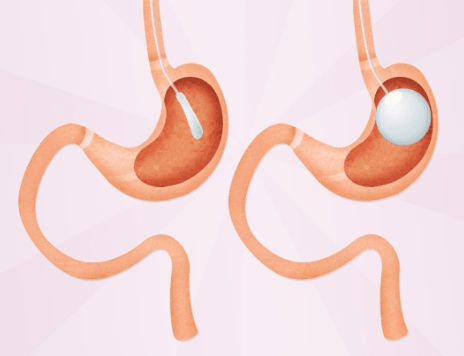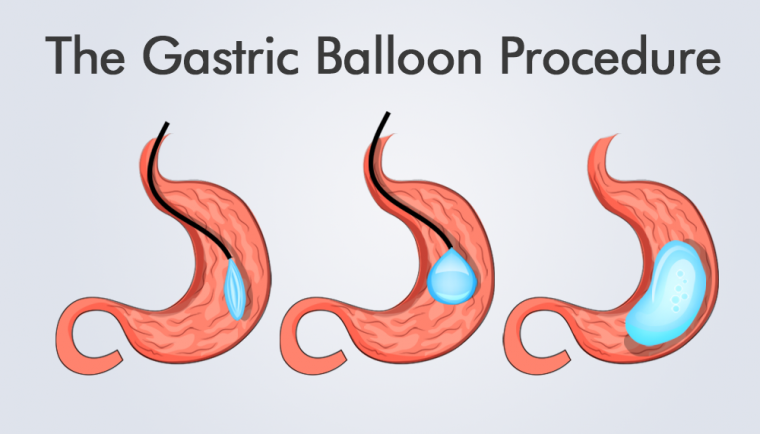What you need to know about Gastric Balloon Procedure
Contents
A gastric balloon is a type of weight-loss treatment performed to help people with obesity lose significant weight. It is a nonsurgical procedure that involves placing a saline-filled silicone balloon into your stomach. This balloon obstructs a sizable area of your stomach, thus limiting how much you can eat and making you feel fuller faster. The balloon is designed to stay in your stomach for only six months before it is removed. After six months, the balloon is deflated and removed from your stomach, allowing you to have your normal stomach size back.
The gastric balloon will help you lose weight and lower your risks of potentially life-threatening weight-related diseases, such as heart disease or stroke, high blood pressure, gastroesophageal reflux disease (GERD), obstructive sleep apnea, type 2 diabetes, and nonalcoholic fatty liver disease (NAFLD) or nonalcoholic steatohepatitis (NASH).
You may consider gastric balloon if your body mass index (BMI) is between 30 and 40, and diet and exercise have not worked for you.
After gastric balloon, you will be able to lose significant weight. As a result, your risk of developing weight-related diseases is reduced and you can enjoy more activities that you could not do before. You may also become more comfortable and confident with yourself. In the end, the procedure will increase your quality of life.

What does the Procedure Involve?
During gastric balloon insertion, you will be given mild anesthetic and sedative to help you relax.
Your doctor will insert a thin tube (catheter) loaded with the silicone balloon down through your throat and into your stomach. Next, your doctor advances an endoscope down your throat and into the stomach. An endoscope is a thin, flexible tube with a camera and light attached to its end. The camera helps your doctor get a clear picture of the inside of your stomach without having to surgically open your abdomen. Once the endoscope and the balloon reach your stomach, the balloon is filled with sterile saline through the catheter that is attached to the balloon. The balloon is filled until it is too large to pass through the small intestine.
After the balloon is successfully inserted and filled with saline, your stomach capacity is decreased by 700 ml.

How Long Should I Stay at my Destination?
Gastric balloon insertion takes approximately 20 to 30 minutes to complete. It is an outpatient procedure, meaning you can leave the hospital on the same day once the effect of the anesthesia wears off. Still, you should plan to stay in the area for at least 7 to 10 days for follow-up checkups where your doctor will make sure that the balloon is not causing any issues. If everything goes according to plan, you will be allowed to fly home.
What’s the Recovery Time?
The first few days after gastric balloon insertion, you may experience pain, nausea, and vomiting. However, you should be able to go back to most of your normal activities, including work within the next day (if your job is not physically demanding). Make sure to discuss with your doctor your recovery timeline.
What About Aftercare?
Your doctor will give you detailed aftercare instructions, which may include a diet plan. During the first week, you are only allowed to consume liquid. You may be able to start eating soft foods at the start of the second week. It may take around three weeks after the gastric balloon insertion until you can start eating regular food.
To maximize and maintain your weight loss, it is important that you commit to a healthy lifestyle. Be sure to exercise regularly with the help of expert supervision. You need to talk to your doctor and a nutritionist about your diet plan because you have to fulfill your body’s nutritional requirement with less food. You also need to take vitamins, minerals, and other supplements regularly. In addition, you have to attend regular checkups where your doctor monitors your weight loss. You can choose to have your checkups with your local doctor back home.
What’s the Success Rate?
A gastric balloon is a safe and effective procedure. Women typically lose around 2 to 3 kilograms of their body weight in the first week, while men may lose around 4 to 7 kilograms. On average, patients lose around 7% to 15% of their excess weight during the six months that the gastric balloon is inside their stomach. The total weight loss after a gastric balloon ranges from 30% to 47%.
Although the gastric balloon is generally safe, you still need to be aware of the possible side effects and risks the procedure carries. The anesthesia and endoscope used in the insertion of the balloon can cause side effects such as stomach cramps, nausea, vomiting, discomfort, and reflux. In some cases, patients may also experience bloating, indigestion, diarrhea, abdominal or back pain, flatulence, and heavy feeling in the abdomen. All of these side effects are usually temporary and should subside on their own without any treatment.
In very rare cases, the balloon can deflate by itself and slip into the lower intestines. This can cause blockage in your digestive system, resulting in bowel obstruction. If this happens, additional surgery to remove the balloon is needed. Other rare, but possible complications are ulcers and perforation in the stomach wall, which would need surgery to treat.
For an in-depth analysis of a Gastric Balloon Procedure, watch this short video.
Are there Alternatives to Gastric Balloon Procedure?
If a gastric balloon is not for you, you can consider other types of bariatric procedures:
- Gastric bypass – during a gastric bypass, a small pouch is created in your stomach and part of your digestive system is rerouted (bypassed). The procedure essentially alters your anatomy so you cannot eat as much as you used to and your body cannot absorb as much food. This type of bariatric procedure is considered as one of the most effective.
- Gastric sleeve – this procedure involves removing parts of your stomach to reduce its size. Your stomach will be shaped like a sleeve/banana.
- Gastric band – an inflatable silicone band is placed at the upper part of the stomach in order to reduce its size.
To check prices or to book a Gastric Balloon Procedure in Thailand or anywhere else in the world, head on over to MyMediTravel now!

